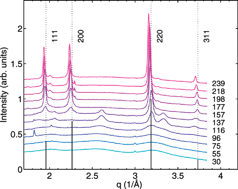To study nano-inks with relatively low sintering temperatures for fabrication of functional electronics on paper by inkjet printing technology, we have successfully prepared copper sulfide nanocrystallites protected by self-assembled monolayers. Systematic characterization was performed on as-prepared nanoparticles by FTIR, NMR, thermogravimetric analysis (TGA), high-resolution transmission electron microscopy (HRTEM), X-ray photoelectron spectroscopy (XPS), and wide-angle X-ray scattering (WAXS) with heating. The copper sulfide nanocrystallites with crystal sizes <1.5 nm show a hexagonal Cu2S phase at low temperatures but undergo significant consolidation/crystallization from 100 to 240 °C, accompanying a transformation from the hexagonal Cu2S phase to the cubic Cu1.8S phase when heated up to ca. 150 °C. The protective ligand burnout during heating is closely associated with the nanocrystallite consolidation. Further, the copper sulfide nanoparticles were deposited on paper and sintered at 240 °C in air. The sintered particles are composed of large crystals of cubic Cu1.8S with no serious degradation due to oxidation. The resistivity of the sintered particles was of the order of 1 × 10−5 (Ω m).

You have access to this article
 Please wait while we load your content...
Something went wrong. Try again?
Please wait while we load your content...
Something went wrong. Try again?


 Please wait while we load your content...
Please wait while we load your content...